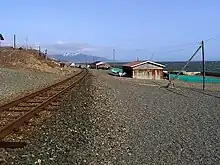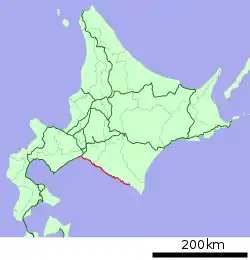| Hidaka Main Line | |||
|---|---|---|---|
 A local train on the Hidaka Main Line between Okaribe and Seppu in October 2011 | |||
| Overview | |||
| Native name | 日高本線 | ||
| Status | Operational (As a railway between Tomakomai and Mukawa) (As a bus route between Mukawa and Samani) | ||
| Owner | JR Hokkaido | ||
| Locale | Hokkaido | ||
| Termini | |||
| Stations | 29 (until January 2015) 5 (after January 2015) | ||
| Service | |||
| Type | Heavy rail | ||
| Operator(s) | JR Hokkaido | ||
| Rolling stock | KiHa 40 series DMU, Bus | ||
| History | |||
| Opened | October 1913 | ||
| Closed | 1 April 2021 (section between Mukawa and Samani was replaced by a bus service in January 2015 but only formally closed as a railway on 1 April 2021) | ||
| Technical | |||
| Line length | 146.5 km (91.0 mi) (until January 2015) 30.5 km (19.0 mi) (after January 2015) | ||
| Number of tracks | Entire line single tracked | ||
| Character | Rural | ||
| Track gauge | 1,067 mm (3 ft 6 in) | ||
| Old gauge | 762 mm (2 ft 6 in) | ||
| Electrification | None | ||
| Operating speed | 95 km/h (59 mph) | ||
| |||
The Hidaka Main Line (日高本線, Hidaka-honsen) is a railway line in Hokkaido, Japan, operated by Hokkaido Railway Company (JR Hokkaido), between Tomakomai Station in Tomakomai and Samani Station in Samani, running along the coast of Hidaka Subprefecture. Services on the 116.0 km (72.1 mi) section of the line beyond Mukawa Station were suspended indefinitely since January 2015 due to storm damage. This section was closed on 1 April 2021 and replaced by a bus service. The closure of this section made the line the shortest in Japan to be classified as a 'main line', at just 30.5 km (19.0 mi), beating the Rumoi Main Line's length of 50.1 km (31.1 mi), which was previously the shortest.
Services

All regular trains are local trains, which stop at all stations, except Hama-Taura that may be skipped by some trains.
Stations
| Station | Distance (km) |
Transfers | Location | ||
|---|---|---|---|---|---|
| H18 | Tomakomai | 苫小牧 | 0.0 | ■ Muroran Main Line ■ Chitose Line |
Tomakomai |
| Yūfutsu | 勇払 | 13.1 | |||
| Hama-Atsuma | 浜厚真 | 22.7 | Atsuma, Yūfutsu District | ||
| Hama-Taura | 浜田浦 | 27.0 | Mukawa, Yūfutsu District | ||
| Mukawa | 鵡川 | 30.5 | |||
| Shiomi | 汐見 | 34.5 | |||
| Tomikawa | 富川 | 43.6 | Hidaka, Saru District | ||
| Hidaka-Mombetsu | 日高門別 | 51.3 | |||
| Toyosato | 豊郷 | 56.3 | |||
| Kiyohata | 清畠 | 61.1 | |||
| Atsuga | 厚賀 | 65.6 | |||
| Ōkaribe | 大狩部 | 71.1 | Niikappu, Niikappu District | ||
| Seppu | 節婦 | 73.1 | |||
| Niikappu | 新冠 | 77.2 | |||
| Shizunai | 静内 | 82.1 | Shinhidaka, Hidaka District | ||
| Higashi-Shizunai | 東静内 | 90.9 | |||
| Harutachi | 春立 | 97.0 | |||
| Hidaka-Tōbetsu | 日高東別 | 99.4 | |||
| Hidaka-Mitsuishi | 日高三石 | 105.8 | |||
| Hōei | 蓬栄 | 109.8 | |||
| Honkiri | 本桐 | 113.0 | |||
| Ogifushi | 荻伏 | 120.2 | Urakawa, Urakawa District | ||
| Efue | 絵笛 | 125.1 | |||
| Urakawa | 浦河 | 130.3 | |||
| Higashichō | 東町 | 132.4 | |||
| Hidaka-Horobetsu | 日高幌別 | 136.9 | |||
| Utoma | 鵜苫 | 141.1 | Samani, Samani District | ||
| Nishi-Samani | 西様似 | 143.6 | |||
| Samani | 様似 | 146.5 | |||
History
The first section was opened in October 1913 by the Tomakomai Light Railway (苫小牧軽便鉄道, Tomakomai Keiben Tetsudō), operating between Tomakomai and Sarufuto (佐瑠太) (present-day Tomikawa).[1] The section between Sarufuto and Shizunai was operated by the Hidaka Takushoku Railway (日高拓殖鉄道, Hidaka Takushoku Tetsudō). Both lines were light railways with a track gauge of 762 mm (2 ft 6 in).[2]
The lines were nationalized on 1 August 1927, and merged into one, becoming the Hidaka Line.[2] The track gauge was widened to 1,067 mm (3 ft 6 in) between Tomakomai and Sarufuto on 26 November 1929, and between Sarafuto and Shizunai on 10 November 1931.[2] The line was extended from Shizunai to Hidaka-Mitsuishi on 15 December 1933, to Urakawa on 24 October 1935, and to Samani on 10 August 1937.[2]
With the privatization of JNR on 1 April 1987, the line came under the control of JR Hokkaido.[2]
Service suspension
Following storm damage between Atsuga and Ōkaribe stations on 8 January 2015,[3] rail services had been suspended on the 116.0 km (72.1 mi) section beyond Mukawa station, with buses providing a substitute service. Further damage was caused to the line by Typhoon 17 on 12 September 2015, and no date had been set for the resumption of rail services beyond Mukawa. In December 2016, JR Hokkaido announced that it had abandoned plans to reopen the suspended section of the line, and was in discussion with the local governments involved.[1]
Due to low ridership and very high maintenance costs, including coastal defences between Atsuga and Ōkaribe, JR Hokkaido held several meetings and conferences with the 7 towns along the suspended segment of the line, suggesting that repair of the line be abandoned and replaced by a bus service. In November 2019, 6 out of the 7 towns agreed that the damaged section be replaced by a bus service. However, the town of Urakawa still strongly requested for the whole line to be repaired; Urakawa's mayor reasoned that it would still take a while for the 'developing' Hidaka Expressway to reach the town, therefore it being necessary for the line to remain in service.
In September 2020, after 5 years of various meetings and discussions, many of which involved extensive arguments and disagreements, all 7 towns eventually came to the decision, along with JR Hokkaido, that the damaged section be abandoned and replaced with a bus service. The 116.0 km (72.1 mi) section was formally closed on 1 April 2021.[4]
See also
References
- 1 2 日高本線・鵡川~様似間の復旧を断念 JR北海道、地元と協議へ [JR Hokkaido abandons reopening of Hidaka Main Line between Mukawa and Samani]. Traffic News (in Japanese). Japan: Mediavague Co. Ltd. 22 December 2016. Archived from the original on 22 December 2016. Retrieved 4 April 2017.
- 1 2 3 4 5 Ishino, Tetsu, ed. (1998). 停車場変遷大辞典 国鉄・JR編 [Station Transition Directory - JNR/JR] (in Japanese). Vol. I. Japan: JTB. p. 128. ISBN 4-533-02980-9.
- ↑ 日高線 厚賀~大狩部間 67k506m 付近における盛土流出について [Trackbed damage on Hidaka Line between Atsuga and Ōkaribe] (PDF). News release (in Japanese). Japan: Hokkaido Railway Company. 13 January 2015. Archived (PDF) from the original on 4 March 2016. Retrieved 4 April 2017.
- ↑ "鉄道事業の一部廃止の日を繰上げる届出について" (PDF). MLIT. 5 January 2021. Archived (PDF) from the original on 5 January 2021.
External links
- JR Hokkaido official website Archived 29 November 2006 at the Wayback Machine
